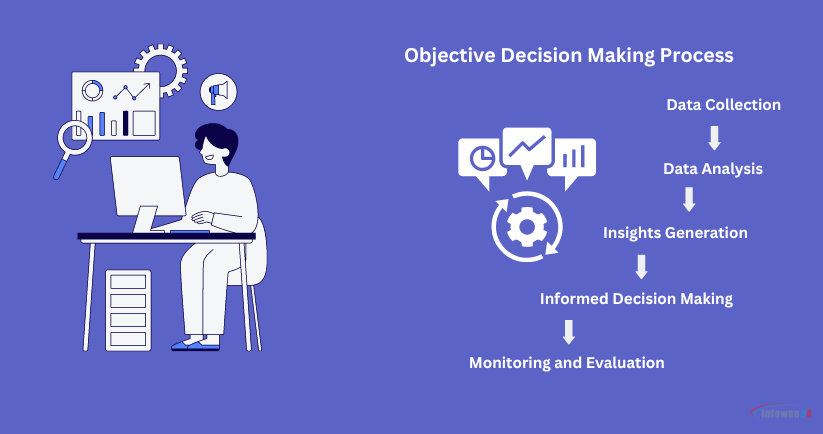
How can we help you today?
Registered Office
Infowan Technologies Pvt Ltd
Mumbai-401107. INDIA.
Contact Details
+91 98201 97205
+91 98201 26871
+91 98670 74415
support@infowan.net
info@infowan.net
|
Table of Contents
|
|---|
| Data driven decision making has become a cornerstone of effective HR strategies. |
| The Shift Toward Data-Driven HR Analytics |
| What is Data-Driven Decision Making in HR Analytics? |
| What is HR analytics? |
| The Cornerstones of Data-Driven Payroll HRMS Software |

Data-driven decision-making is the process of making decisions based on data analysis rather than intuition or personal experience. When applied to HR software, it involves collecting, analyzing, and interpreting data to inform talent management strategies and decision-making processes. By leveraging data, HR professionals can gain insights into employee behavior, performance, and engagement and use this information to develop effective recruitment, training, and retention programs. Data-driven decision-making can also help HR identify areas for improvement and measure the impact of HR initiatives on business outcomes. Ultimately, data-driven decision-making can lead to a more strategic and effective HR function that helps drive organizational success.
In data-driven HR decision-making, information is gathered from various sources, such as employee surveys, performance metrics, turnover rates, engagement scores, recruitment data, and more. This information is then transformed into actionable insights through careful analysis. These insights enable HR professionals to optimize processes, identify patterns and trends, solve challenges, and strategically allocate resources. Whether it's enhancing talent acquisition strategies, refining employee training programs, or predicting turnover risks, data-driven decision-making empowers HR to implement more effective, efficient, and equitable solutions that drive positive outcomes for both employees and the organization as a whole.
The Shift Toward Data-Driven HR AnalyticsTraditionally, HR decisions were often based on intuition, past experiences, and gut feelings. However, this approach lacked the precision and objectivity needed to address complex workforce challenges. Enter data-driven decision-making in HR, a paradigm shift that's redefining how HR professionals operate.
What is Data-Driven Decision Making in HR Analytics?Data-driven decision-making in payroll HR software involves harnessing the power of data and analytics to inform and guide HR strategies, policies, and practices. It's about leveraging quantitative insights and evidence to make informed choices that impact employees, processes, and the organization's bottom line
What is HR analytics?HR analytics is the process of collecting, analyzing, and interpreting data about an organization's workforce. This data can be used to improve HR practices, such as recruitment, selection, training, and development.
HR analytics can be used to: • Identify trends in employee turnover, absenteeism, and productivity.Data-driven insights identify skill gaps within the workforce, enabling HR to tailor training programs to individual and organizational needs. Organizations that embrace data-driven HR gain a competitive edge in attracting, retaining, and developing top talent.
The Cornerstones of Data-Driven Payroll HRMS Software
1.
Recruitment and Talent Acquisition:
•
Data analytics enable HR teams to identify the most effective recruitment channels, reducing
time-to-fill positions and improving the quality of hires.
•
Predictive analytics help in forecasting future talent needs, and aligning recruitment strategies
with long-term organizational goals.
2.
Employee Engagement and Retention:
•
By analyzing engagement survey data, HR can pinpoint areas for improvement and implement targeted
initiatives to boost employee satisfaction.
•
Predictive modeling identifies flight-risk employees, allowing for proactive retention efforts.
3.
Performance Management:
•
Data-driven performance management shifts the focus from annual reviews to continuous feedback.
•
Real-time performance metrics aid in setting benchmarks, offering timely coaching, and recognizing
high performers.
4.
Diversity and Inclusion:
•
Data analytics reveal diversity metrics, such as representation at different levels of the organization.
•
By identifying disparities, HR can design inclusive policies and practices that foster diversity.
5.
Learning and Development:
•
Data-driven insights identify skills gaps within the workforce, enabling HR to tailor training
programs to individual and organizational needs.
•
Learning analytics track the effectiveness of training initiatives, ensuring a return on investment.
While data-driven HR offers numerous advantages, it's essential to address challenges like data privacy, ethical considerations, and the need for data literacy among HR professionals. Overall, HR analytics can be a valuable tool for organizations that are looking to improve their HR practices and achieve their strategic goals.